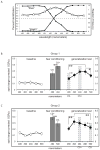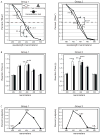Effects of discrimination training on fear generalization gradients and perceptual classification in humans
- PMID: 23421709
- PMCID: PMC3707295
- DOI: 10.1037/a0031933
Effects of discrimination training on fear generalization gradients and perceptual classification in humans
Abstract
To examine the effect of discriminative fear conditioning on the shape of the generalization gradient, two groups of participants first learned to discriminate between two color stimuli, one paired with an electrical shock (conditional stimulus, CS+) and the other explicitly unpaired (CS-). The CS+ was held constant as an intermediate (ambiguous) value along the blue-green color dimension while the CS- varied between groups as opposite endpoints along the blue-green color dimension. Postdiscrimination testing, using spectral wavelengths above and below the CS+, revealed opposing asymmetric gradients of conditioned skin conductance responses across training groups that skewed in a direction opposite the CS-. Moreover, perceptual ratings for the color of the CS+ were affected by discriminative conditioning, with the color value of the blue or green CS- inducing a shift in the frequency for ratings of the ambiguous CS+ as either "green" or "blue," respectively. These results extend findings on gradient shifts in the animal literature and suggest that postdiscrimination testing provides a more comprehensive estimate of the effects of discriminative fear conditioning than testing responses solely to the conditioned stimuli.
PsycINFO Database Record (c) 2013 APA, all rights reserved.
Figures


Similar articles
-
Generalization of conditioned fear along a dimension of increasing fear intensity.Learn Mem. 2009 Jun 24;16(7):460-9. doi: 10.1101/lm.1431609. Print 2009 Jul. Learn Mem. 2009. PMID: 19553384 Free PMC article.
-
The relationship of perceptual discrimination to neural mechanisms of fear generalization.Neuroimage. 2019 Mar;188:445-455. doi: 10.1016/j.neuroimage.2018.12.034. Epub 2018 Dec 18. Neuroimage. 2019. PMID: 30572112
-
Fear generalization in humans: impact of feature learning on conditioning and extinction.Neurobiol Learn Mem. 2014 Sep;113:143-8. doi: 10.1016/j.nlm.2013.10.002. Epub 2013 Oct 9. Neurobiol Learn Mem. 2014. PMID: 24120427
-
Translational approaches to the neurobiological study of conditional discrimination and inhibition: Implications for psychiatric disease.Behav Neurosci. 2024 Aug;138(4):244-259. doi: 10.1037/bne0000594. Epub 2024 Jun 24. Behav Neurosci. 2024. PMID: 38913706 Free PMC article. Review.
-
The (shared) features of fear: Toward the source of human fear responding.Curr Opin Psychol. 2021 Oct;41:113-117. doi: 10.1016/j.copsyc.2021.07.005. Epub 2021 Jul 17. Curr Opin Psychol. 2021. PMID: 34412002 Review.
Cited by
-
Examining the impact of cue similarity and fear learning on perceptual tuning.Sci Rep. 2023 Aug 10;13(1):13009. doi: 10.1038/s41598-023-40166-w. Sci Rep. 2023. PMID: 37563349 Free PMC article.
-
Visual Aversive Learning Compromises Sensory Discrimination.J Neurosci. 2018 Mar 14;38(11):2766-2779. doi: 10.1523/JNEUROSCI.0889-17.2017. Epub 2018 Feb 8. J Neurosci. 2018. PMID: 29439168 Free PMC article.
-
Safety signals in the primate amygdala.J Neurosci. 2013 Nov 13;33(46):17986-94. doi: 10.1523/JNEUROSCI.1539-13.2013. J Neurosci. 2013. PMID: 24227710 Free PMC article.
-
A parametric study of fear generalization to faces and non-face objects: relationship to discrimination thresholds.Front Hum Neurosci. 2014 Sep 5;8:624. doi: 10.3389/fnhum.2014.00624. eCollection 2014. Front Hum Neurosci. 2014. PMID: 25249955 Free PMC article.
-
Aversive outcomes impact human olfactory discrimination learning and generalization.Behav Neurosci. 2021 Oct;135(5):642-653. doi: 10.1037/bne0000476. Epub 2021 Jul 1. Behav Neurosci. 2021. PMID: 34197137 Free PMC article.
References
-
- Doll TJ, Thomas DR. Effects of discrimination training on stimulus generalization for human subjects. Journal of Experimental Psychology. 1967;75(4):508. doi: 10.1037/h0025116. - DOI
-
- Galizio M, Baron A. Human postdiscrimination gradients: The effects of three-stimulus discrimination training. Animal Learning & Behavior. 1979;7(1):53–56. doi: 10.3758/bf03209657. - DOI
-
- Gamberale-Stille G, Tullberg BS. Experienced chicks show biased avoidance of stronger signals: an experiment with natural colour variation in live aposematic prey. Evolutionary Ecology. 1999;13(6):579–589. doi: 10.1023/a:1006741626575. - DOI
-
- Guttman N, Kalish HI. Discriminability and stimulus-generalization. Journal of Experimental Psychology. 1956;51(1):79–88. - PubMed
Publication types
MeSH terms
Grants and funding
LinkOut - more resources
Full Text Sources
Other Literature Sources

